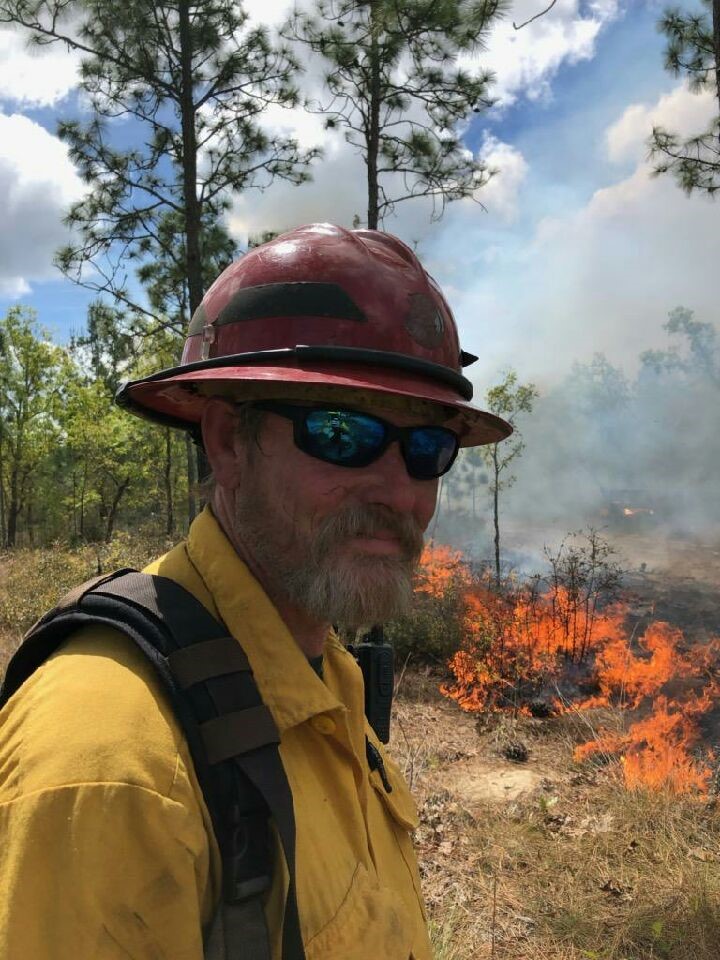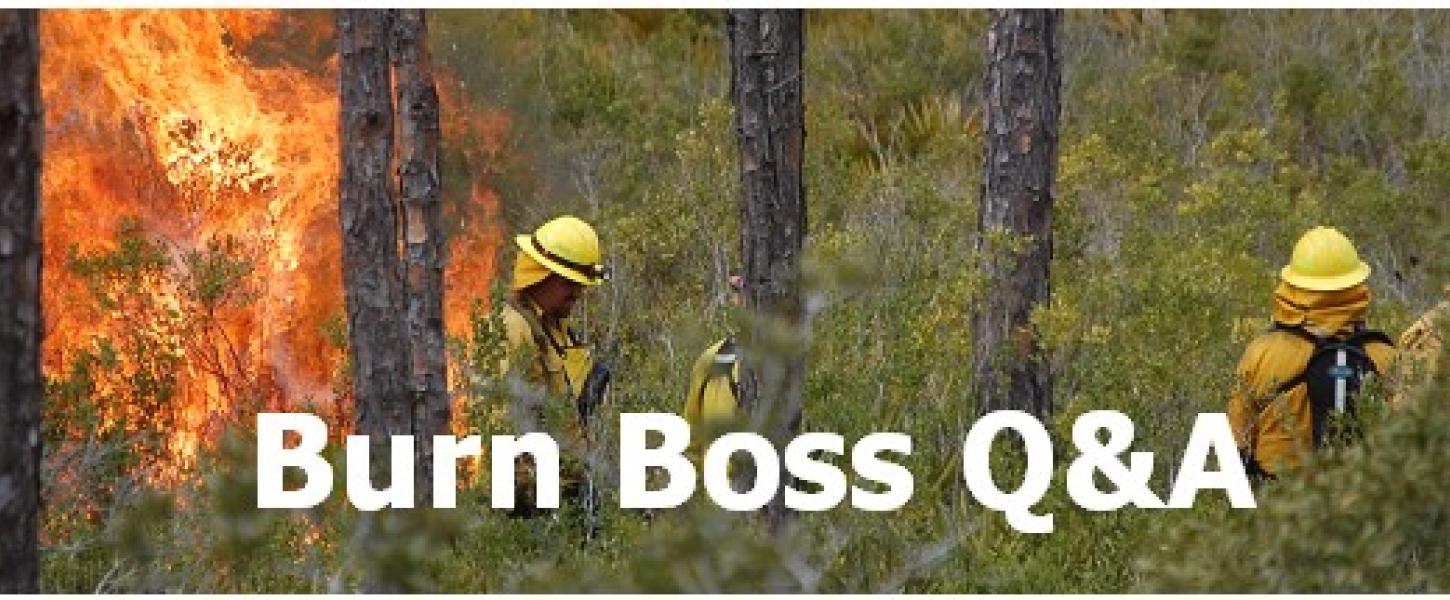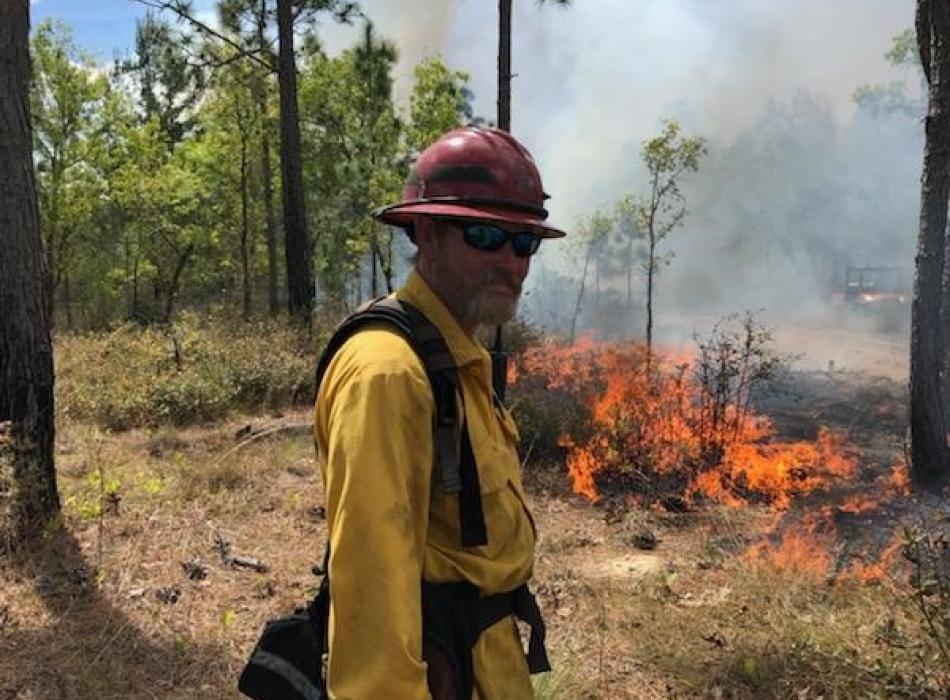
Burn Boss Q&A with Kevin Patton

Interview with a Burn Boss: Kevin Patton
Can you tell us about the most difficult burn you have done? Tell us why it was difficult and what situations drove you to make tough decisions. Also tell us what you did well, what needed improvements and what you ultimately learned.
When I became park manager of Bald Point State Park, I stepped into a 5,000-acre coastal park with very little prescribed fire history. The fuels consisted of scrubby flatwoods, scrub and mesic flatwoods, as well as extensive areas of pine plantation, planted dog-hair thick. The shrub level in many areas was just five to 10 feet below the canopy.
Also present were large areas of fresh and saltwater marsh systems consisting of potentially volatile sawgrass and needlerush. In the many areas of pine plantation, timber harvesting and thinning were utilized to reduce fuel levels, leaving just enough of the pine canopy to provide needle drop to implement prescribed fire to further reduce fuel levels. Aerial burning was used extensively, so that large areas of the park could be put back into maintenance condition. Aerial burning was also utilized for crew safety, allowing holding and ignition crews to stay outside of the tremendous fuel loadings within the zones.
My most difficult burn occurred at Bald Point State Park on March 27, 2008, on a ground-ignition fire. This was one of the smaller zones in the park, Zone CC. This zone was around 80 acres, consisting of mesic flatwoods interspersed with sawgrass marsh and needlerush marsh. The zone had a natural stand of slash pines with significant areas of duff. Zone CC had no burn history.
The Keetch-Byram Drought Index (KBDI) was 280, which is on the wet end of the spectrum (0 to 800). We were burning with a west wind. To the east of Zone CC was Big Tucker Lake, a large saltwater lake system. The lake served as a natural downwind fire break. The crew was very experienced. I decided to burn the zone with ground ignition because most of the areas around it had been aerially burned the previous year, greatly reducing fuel levels.
At first, the fire behavior was manageable and what you would expect from such high fuel loadings. As the day went on and temperatures became hotter and relative humidity started to drop (but still within our predicted weather parameters), spotting started to occur. This was in the areas that had been burned the previous year. There was very little fuel in these areas. The groundcover included very sparse needle-drop from pine trees, along with mineral soil; but also present were pockets of very fine duff where the top layer had been burned off. This very fine particulate matter had been exposed and baked by the sun for a year. This made it a perfect receptor to any hot ash dropping on it.
Although it did not look like it would burn, it did.
The crew started to stretch out, catching spots. The water resources were quickly used up. When the fire reached some of the sawgrass marsh areas, it was backing into these fine fuels faster than we could keep the flanks pulled up to it. This was due to us suppressing spots and having to refill our trucks. It was everything we could do to keep black lines even with the fire backing across these marsh areas, which were also mixed with islands of slash pine.
We were also experiencing small wind changes that would slam our flanking black lines, causing multiple spots each time. This burn was like holding a monster by its tail.
That day I saw some of the most volatile burn conditions I had ever experienced. Most of it was fuel driven. We were eventually able to pull our black lines up to the lake, containing the fire.
The next day I employed a private gyro tract contractor to cut in and around the spot areas that were smoldering. This was to secure them and ensure that they would not reignite. Then we set up an extensive sprinkler system to suppress areas of smoldering duff within the zone. We utilized several nearby freshwater lakes to pump fresh water to the sprinkler system. It took a month to totally suppress this fire.
Even after a significant rain and weeks of pumping water on the zone, we had about a one-acre reburn. There was standing water within the zone when this occurred.
John Lakich, now park manager at Jonathan Dickinson State Park, and I pumped so much water out of one of the small freshwater lakes that it turned salty.
What did I learn from this?
- You need to have more crew and equipment on-site than you think you need. Put the minimum on your prescription so not to limit your ability to burn, but bring in more than you have on your prescription for the actual burn. We had enough crew to do the burn but once conditions changed, it was very difficult to deal with all that was going wrong. It’s better to have more than you need, instead of not enough.
- KBDI will lie to you. Dig into the duff and look at your local conditions to ensure that the entire duff layer is moist or saturated. Just because something does not look like or should not burn does not mean that it will not. Even if all your downwind fuels are black, consider that area as a receptive fuel and an avenue for escape. Sometimes areas that have been burned make the organic soils more receptive to spotting.
- You take just as much risk burning small acreage as you do burning large acreage. Being confident is a must, but ego will get you in trouble. Be willing to share your mistakes and successes with other people so they can learn from them.
This was a very difficult burn that stays fresh in my memory. It’s a good reminder to always keep your options open.
What are some of the roadblocks to considering a management zone as “burnable” and how do you overcome these?
One roadblock is when the fuel loadings are too high or in and around urban interface areas. This can be mitigated with mechanical fuel reduction. “Firewise” programs in adjacent local communities encourage fuel reduction on private lands.
Another roadblock can be smoke management issues on the roads or other smoke-sensitive areas. This can be addressed by working with local and state agencies, planning road closures or bringing additional resources for mop-up. Always work with a local fire weather forecaster at the National Weather Service to closely monitor weather conditions for narrow burn windows.
Work with landowners with private inholdings for management agreements to include their properties within the burns and then communicate with them frequently during burn season.
A lack of on-hand resources should not stop a safe burn program. Form partnerships with other resource management agencies to share needed resources. Foster good relations with local fire departments. Reach out to other state parks for assistance. Safety first!

What are your thoughts about the completeness of a burn? Should we strive to have everything black at the end of the day or should we vary our techniques or weather conditions so we have un-burned refugia within the zone?
The answer to the question depends upon your objectives. If you are just trying to reduce fuel, then yes, you want to get as much of it burned as possible. If you have areas that are specific habitat that you need for something like an endangered species, then no, you would pick conditions or take actions that would ensure that those areas were left unburned.
These decisions should be based on what you are trying to accomplish and what is best for the resources you are trying to maintain or restore.
About the Author

Kevin Patton joined the Florida Park Service in 1986. He was a park ranger at Ravine Gardens, O’Leno and Paynes Prairie Preserve state parks. He was promoted to assistant park manager at Stephen Foster, Big Shoals and Olustee Battlefield in December 1999. Kevin has served as a park manager since 2005, starting at Ochlockonee River and Bald Point state parks. He is currently the park manager at Mike Roess Gold Head Branch State Park.
He became a burn boss in 1999 and has bossed more than 79 burns in his career, serving on a total of 241 burns.
About the Burn Boss Q&A Series
Florida’s state parks add tremendous value to Florida’s natural environment. The division’s burn bosses lead the efforts to implement fire plans in ecosystems that require fire for maximum health. This project highlights the diverse, balanced and quality professional workforce of burn bosses by having them share lessons learned with other staff members. Select staff were presented with 20 questions. They are asked to answer three to five of them.